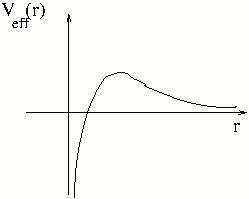Read the following discussion of conditions under which a particle can fall to centre in a spherically symmetric potential and answer the question \(\langle \text{\TheFile}\rangle\) at the end.
| Fall to Center | |
| Let V(r) be finite as r $\longrightarrow$ 0. Then $V_\text{eff}(r) \longrightarrow \infty$ as $r\longrightarrow 0$ and a particle cannot reach r=0 for any value of \(E\). However, for certain singular potentials the particle can reach center. Consider, for example, the case of a potential $V = \frac{-g}{r^{4}}, \quad g > 0$. Then the effective potential is \begin{equation} V_\text{eff} = \frac{-g}{r^{4}} + \frac{L^{2}}{2mr^{2}} \end{equation} A sketch of the effective potential is shown in \Figref{cm-drw-0502}. If $ E > \text{ maximum of }\ V_\text{eff}$, then a particle coming from large distance can fall to center. |
 |
Question
A criticism of Rutherford model of atom is that an electron will keep loosing energy due to radiation. The radius of its orbit will become shorter and shorter and eventually it will fall to the nucleus.
How do we understand this statement in light of above discussion of fall to centre?
Remember that for Coulomb potential the effective potential is infinite at \(r=0\), if angular momentum is nonzero.
Exclude node summary :
Exclude node links:
4727:Diamond Point






 ||Message]
||Message]
